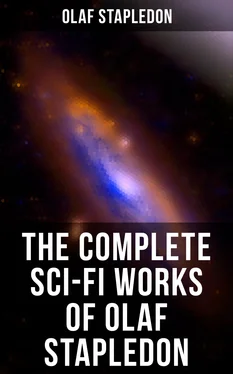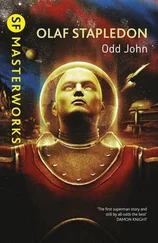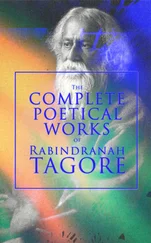Olaf Stapledon - The Complete Sci-Fi Works of Olaf Stapledon
Здесь есть возможность читать онлайн «Olaf Stapledon - The Complete Sci-Fi Works of Olaf Stapledon» — ознакомительный отрывок электронной книги совершенно бесплатно, а после прочтения отрывка купить полную версию. В некоторых случаях можно слушать аудио, скачать через торрент в формате fb2 и присутствует краткое содержание. Жанр: unrecognised, на английском языке. Описание произведения, (предисловие) а так же отзывы посетителей доступны на портале библиотеки ЛибКат.
- Название:The Complete Sci-Fi Works of Olaf Stapledon
- Автор:
- Жанр:
- Год:неизвестен
- ISBN:нет данных
- Рейтинг книги:5 / 5. Голосов: 1
-
Избранное:Добавить в избранное
- Отзывы:
-
Ваша оценка:
- 100
- 1
- 2
- 3
- 4
- 5
The Complete Sci-Fi Works of Olaf Stapledon: краткое содержание, описание и аннотация
Предлагаем к чтению аннотацию, описание, краткое содержание или предисловие (зависит от того, что написал сам автор книги «The Complete Sci-Fi Works of Olaf Stapledon»). Если вы не нашли необходимую информацию о книге — напишите в комментариях, мы постараемся отыскать её.
Novels:
Last and First Men: A Story of the Near and Far Future
Last Men in London
Odd John: A Story Between Jest and Earnest
Star Maker
Darkness and the Light
Sirius: A Fantasy of Love and Discord
Death into Life
Short Stories:
The Flames (1947)
The Seed and the Flower
The Road to the Aide Post
A Modern Magician
East is West
A World of Sounds
Arms Out of Hand
The Complete Sci-Fi Works of Olaf Stapledon — читать онлайн ознакомительный отрывок
Ниже представлен текст книги, разбитый по страницам. Система сохранения места последней прочитанной страницы, позволяет с удобством читать онлайн бесплатно книгу «The Complete Sci-Fi Works of Olaf Stapledon», без необходимости каждый раз заново искать на чём Вы остановились. Поставьте закладку, и сможете в любой момент перейти на страницу, на которой закончили чтение.
Интервал:
Закладка:
Thus without appreciable change the millennia dragged on in squalid drudgery. For these latter-day barbarians were hampered by living in a used planet. Not only were coal and oil no more, but almost no mineral wealth of any kind remained within reach of their feeble instruments and wits. In particular the minor metals, needed for so many of the multifarious activities of developed material civilization, had long ago disappeared from the more accessible depths of the earth’s crust. Tillage moreover was hampered by the fact that iron itself, which was no longer to be had without mechanical mining, was now inaccessible. Men had been forced to resort once more to stone implements, as their first human ancestors had done. But they lacked both the skill and the persistence of the ancients. Not for them the delicate flaking of the Paleoliths nor the smooth symmetry of the Neoliths. Their tools were but broken pebbles, chipped improvements upon natural stones. On almost every one they engraved the same pathetic symbol, the Swastika or cross, which had been used by the First Men as a sacred emblem throughout their existence, though with varying significance. In this instance it had originally been the figure of an aeroplane diving to destruction, and had been used by the rebels to symbolize the downfall of Gordelpus and the State. But subsequent generations reinterpreted the emblem as the sign manual of a divine ancestor, and as a memento of the golden age from which they were destined to decline for ever, or until the gods should intervene. Almost one might say that in its persistent use of this symbol the first human species unwittingly epitomized its own dual and self-thwarting nature.
The idea of irresistible decay obsessed the race at this time. The generation which brought about the downfall of the World State oppressed its juniors with stories of past amenities and marvels, and hugged to itself the knowledge that the young men had not the wit to rebuild such complexity. Generation by generation, as the circumstances of actual life became more squalid, the legend of past glory became more extravagant. The whole mass of scientific knowledge was rapidly lost, save for a few shreds which were of practical service even in savage life. Fragments of the old culture were indeed preserved in the tangle of folk lore that meshed the globe, but they were distorted beyond recognition. Thus there was a widespread belief that the world had begun as fire, and that life had evolved out of the fire. After the apes had appeared, evolution ceased (so it was said), until divine spirits came down and possessed the female apes, thereby generating human beings. Thus had arisen the golden age of the divine ancestors. But unfortunately after a while the beast in man had triumphed over the god, so that progress had given place to age-long decay. And indeed decay was now unavoidable, until such time as the gods should see fit to come down to cohabit with women and fire the race once more. This faith in the second coming of the gods persisted here and there throughout the First Dark Age, and consoled men for their vague conviction of degeneracy.
Even at the close of the First Dark Age the ruins of the ancient residential pylons still characterized every landscape, often with an effect of senile domination over the hovels of latter-day savages. For the living races dwelt beneath these relics like puny grandchildren playing around the feet of their fathers’ once mightier fathers. So well had the past built, and with such durable materials, that even after a hundred millennia the ruins were still recognizably artifacts. Though for the most part they were of course by now little more than pyramids of debris overgrown with grass and brushwood, most of them retained some stretch of standing wall, and here and there a favoured specimen still reared from its rubble-encumbered base a hundred foot or so of cliff, punctured with windows. Fantastic legends now clustered round these relics. In one myth the men of old had made for themselves huge palaces which could fly. For a thousand years (an aeon to these savages) men had dwelt in unity, and in reverence of the gods; but at last they had become puffed up with their own glory, and had undertaken to fly to the sun and moon and the field of stars, to oust the gods from their bright home. But the gods sowed discord among them, so that they fell a-fighting one another in the upper air, and their swift palaces crashed down to the earth in thousands, to be monuments of man’s folly for ever after. In yet another saga it was the men themselves who were winged. They inhabited dovecots of masonry, with summits overtopping the stars and outraging the gods; who therefore destroyed them. Thus in one form or another, this theme of the downfall of the mighty fliers of old tyrannized over these abject peoples. Their crude tillage, their hunting, their defence against the reviving carnivora, were hampered at every turn by fear of offending the gods by any innovation.
2. THE RISE OF PATAGONIA
Table of Contents
As the centuries piled up, the human species had inevitably diverged once more into many races in the various geographical areas. And each race consisted of a swarm of tribes, each ignorant of all but its immediate neighbours. After many millennia this vast diversification of stocks and cultures made it possible for fresh biological transfusions and revivifications to occur. At last, after many racial copulations, a people arose in whom the ancient dignity of humanity was somewhat restored. Once more there was a real distinction between the progressive and the backward regions, between ‘primitive’ and relatively enlightened cultures.
This rebirth occurred in the Southern Hemisphere. Complex climatic changes had rendered the southern part of South America a fit nursery for civilization. Further, an immense warping of the earth’s crust to the east and south of Patagonia had turned what was once a relatively shallow region of the ocean into a vast new land connecting America with Antarctica by way of the former Falkland Islands and South Georgia, and stretching thence east and north-east into the heart of the Atlantic.
It happened also that in South America the racial conditions were more favourable than elsewhere. After the fall of the First World State the European element in this region had dwindled, and the ancient ‘Indian’ and Peruvian stock had come into dominance. Many thousands of years earlier, this race had achieved a primitive civilization of its own. After its ruin at the hands of the Spaniards, it had seemed a broken and negligible thing; yet it had ever kept itself curiously aloof in spirit from its conquerors. Though the two stocks had mingled inextricably, there remained ever in the remoter parts of this continent a way of life which was foreign to the dominant Americanism. Superficially Americanized, it remained fundamentally ‘Indian’ and unintelligible to the rest of the world. Throughout the former civilization this spirit had lain dormant like a seed in winter; but with the return of barbarism it had sprouted, and quietly spread in all directions. From the interaction of this ancient primitive culture and the many other racial elements left over in the continent from the old cosmopolitan civilization, civil life was to begin once more. Thus in a manner the Incas were at last to triumph over their conquerors.
Various causes, then, combined in South America, and especially in the new and virgin plains of Patagonia, to bring the First Dark Age to an end. The great theme of mind began to repeat itself. But in a minor key. For a grave disability hampered the Patagonians. They began to grow old before their adolescence was completed. In the days of Einstein, an individual’s youth lasted some twenty-five years, and under the World State it had been artificially doubled. After the downfall of civilization the increasing natural brevity of the individual life was no longer concealed by artifice, and at the end of the First Dark Age a boy of fifteen was already settling into middle-age. Patagonian civilization at its height afforded considerable ease and security of life, and enabled man to live to seventy or even eighty; but the period of sensitive and supple youth remained at the very best little more than a decade and a half. Thus the truly young were never able to contribute to culture before they were already at heart middle-aged. At fifteen their bones were definitely becoming brittle, their hair grizzled, their faces lined. Their joints and muscles were stiffening, their brains were no longer quick to learn new adjustments, their fervour was evaporating.
Читать дальшеИнтервал:
Закладка:
Похожие книги на «The Complete Sci-Fi Works of Olaf Stapledon»
Представляем Вашему вниманию похожие книги на «The Complete Sci-Fi Works of Olaf Stapledon» списком для выбора. Мы отобрали схожую по названию и смыслу литературу в надежде предоставить читателям больше вариантов отыскать новые, интересные, ещё непрочитанные произведения.
Обсуждение, отзывы о книге «The Complete Sci-Fi Works of Olaf Stapledon» и просто собственные мнения читателей. Оставьте ваши комментарии, напишите, что Вы думаете о произведении, его смысле или главных героях. Укажите что конкретно понравилось, а что нет, и почему Вы так считаете.












